Railway Company Steamers
The Belfast and County Down Railway Company decided to run paddle steamers between Belfast and Bangor in 1893. The company had a new vessel, the Slieve Donard, built by Messrs Thomson Ltd., Clydebank. An article in the Belfast Newsletter of 17th June 1893 related that 1,000 persons could with safety be accommodated aboard the new vessel and as she was built extra strong 200 or 360 additional would matter little in ordinary weather.
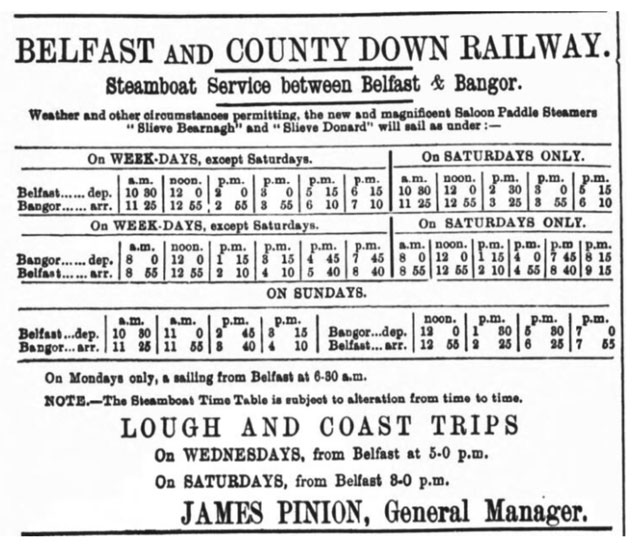
The promenade deck of the Slieve Donard extended for about three-fourths of the total length of the ship and afforded a splendid promenade for first class passengers at the after end and amidships and for second class passengers forward of the funnel. On this deck was the captain’s cabin in a teak house. Right between the paddle boxes and above the house was a flying bridge, with steering wheel communicating with the steam steering gear below. From the promenade deck two wide stairways led to the main deck - the after one for cabin passengers and the forward one for second class. On the main deck at the after end was situated the principal first class saloon, a large airy apartment, with large square windows which could be opened for ventilation. This room was luxuriously upholstered, and the panelling was chiefly in polished oak, relieved by fine scroll work. The sofas had spring seats covered with figured moquette and the floor had a Brussels carpet of similar design. A broad staircase led from the upper saloon to a smaller dining room, below which was a large refreshment bar at one end, and was fitted with marble topped tables on the restaurant principle. Adjoining this saloon was also a ladies refreshment room and there was the usual ladies’ cabin on the main deck above. At the forward end were two roomy saloons for second class passengers, one on the main and one on the lower deck, the latter having a large refreshment bar. The vessel was lighted throughout by a large number of incandescent electric lamps, some of which were arranged on the promenade deck for the convenience of passengers coming on board at night.
The trial trip of the new paddle steamer had taken place the day before. The vessel was under the command of Captain Dalzell Torrance who was recently in charge of the Queen Victoria plying between Liverpool and Douglas. The 2nd officer was James McCorquodale who held the premier position on board the St Tudno, running between the Mersey and Llandudno. The chief engineer was Mr John McCormick and the second was Mr Robert McDowell. During the season the catering on board the Slieve Donard would be in the hands of Mr James Coulter, Belfast. It was noted in the newspaper that the Slieve Donard was not intended as a rival to the two existing boats and there would be no racing. It was expected that the journey between Belfast and Bangor would take under forty minutes. The Belfast Newsletter stated that those who patronised Bangor at that time knew that it was almost impossible for the railway company, in a single line of rails, to carry through the business that presented itself. The newspaper noted that to construct a second line of rails would entail an expenditure of something like £60,000 but as that would be a large item to the mind of the shareholders the building of a steamer to reduce pressure was resorted to.
The following year the Belfast and County Down Railway Company was advertising another new saloon steamer, Slieve Bearnagh, on the Belfast-Bangor route. This vessel had also been built by Messrs J. & G. Thomson and she began sailing between Belfast and Bangor on 20th May 1894 [1].
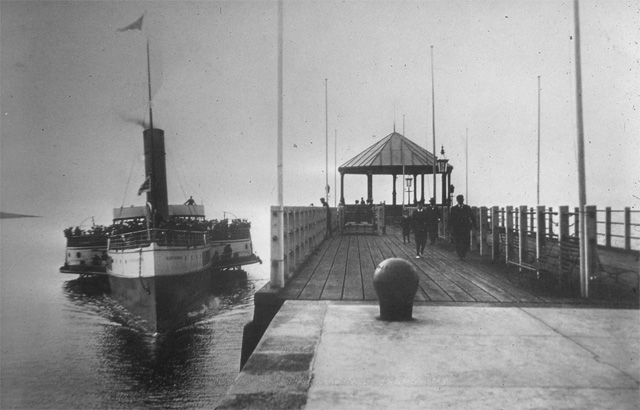 Slieve Bearnagh arriving about 1910, North Down Museum Collection.
Slieve Bearnagh arriving about 1910, North Down Museum Collection.
The company had also bought the Erin from the Belfast, Bangor and Larne Steamboat Company and from Saturday, 2nd June 1894, the old favourite steamer began again sailing from Belfast to Bangor [2]. However, by the following year the Erin was owned by Thomas E. Hawks, Newcastle-on- Tyne and after the vessel became leaky in fine weather on a trip to Norway in 1896 the vessel was abandoned and the crew rescued on 30th May 1896. The Erin was later broken up the same year. The steamer Bangor Castle had been sold to the Plymouth Excursion Steamship Co. Ltd. who then sold her to T. W. Ward Ltd. for demolition on 16th October 1899 [3].
On the night of 21st December 1894 and into the following morning, a great storm raged. It was so severe that on the Upper Clifton Road, Bangor one or two houses were completely unroofed leaving their occupants exposed to the fury of the gale. A large opening was made in the quay wall at Sandy Row and at the entrance to the Lower Clifton Road the quay wall had given way at several points, large boulders having been dashed about almost like so much rubble. The wooden pier used by the Bangor steamers in summer time was completely demolished. A three masted schooner was smashed into the rocks at Ballymacormick Point with the loss of life of three seamen. Two of the deceased were brothers, Sidney Milton aged 22 and his younger brother Ernest aged 20, belonging to Watchet, Somerset. The third was a married man called James Green aged 35, belonging to Fowey, Cornwall. The deceased were buried in Newtownards [4].
After much delay the contract for the new pier at Bangor was entered into on Saturday, 22nd September 1894. Mr R. E. Ward gave the contract for the construction of a new promenade and steamship pier to the firm of Messrs H. & J. Martin. The contract amounted to £25,000 and the work was to begin immediately. Mr L. L. Macassoy, was the engineer. The pier was to be constructed of concrete and the pier end was to be of thirty ton concrete blocks, running out with a timber jetty of greenheart, from which a boat slip would run up. There was to be a neat bandstand on the pier head so that the pier could be utilised for promenades and concerts [5]. The new pier wasn’t to everyone’s satisfaction. At the close of a meeting of the Bangor Commissioners on 18th May 1896, a large deputation was received and a strong complaint was lodged against the carrying of the new pier wall to an unnecessary height of six feet. It was alleged that the fine view of the bay was interfered with so far as the houses in the vicinity were concerned [6].
The new pier was completed in 1897 and a notice was published in the Belfast Newsletter of 14th May 1897 announcing that the public would be admitted to the new pier on payment of a charge of one half penny each way. Annual and season tickets at 10s and 7s 6d each respectively could be obtained on application to the pier master. The tickets were not transferable.
In early 1899 the Belfast and County Down Railway Company sold the steamer, Slieve Donard which left only one steamer, the Slieve Bearnagh, on the Belfast-Bangor route. At the end of the summer season in 1911 the railway company proposed having a new steamer built by Messrs A. & J. Inglis, of Pointhouse, Glasgow to replace the Slieve Bearnagh. The new steamer would be 220ft. in length, 26ft. broad and would have a speed of 16 knots [7]. It had been hoped that the new steamer, Erin’s Isle, would be ready for the start of the season on 18th May 1912 but unfortunately owing to the coal strike and consequent delay in obtaining materials, that couldn’t be accomplished. The delivery of the new vessel was expected towards the end of June. In order to prevent any disappointment to the travelling public, the railway company decided to commence the season’s sailings with the Slieve Bearnagh [8]. However by early June the Belfast and County Down Railway Company had sold the Slieve Bearnagh to Messrs D. & J. Nichol, Dundee.
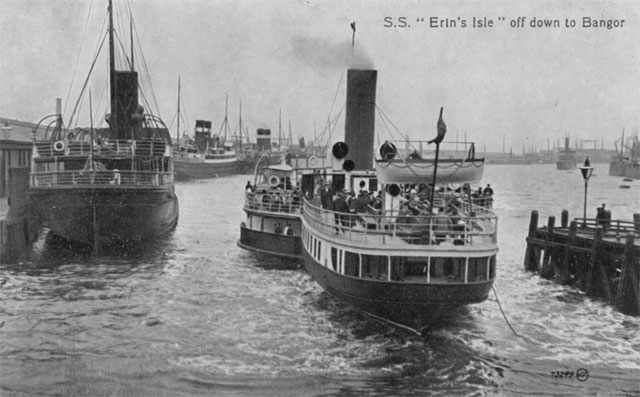 Federation University, Australia, Historical Collection
Federation University, Australia, Historical Collection
The new owners intended to use the steamer in connection with the service between Dundee and North Berwick [9]. The Erin’s Isle was launched on the Clyde on 12th June 1912. It was expected that the fitting out of the steamer would only take three weeks [10]. The new steamer finally arrived in Belfast on the afternoon of 11th July 1912 and the berthing operations at the Queen’s Jetty were witnessed by a big crowd of people assembled on the Queen’s Bridge. Captain Alexander McCorquodale, who had been in the service of the owners for 18 years, was in command of the new vessel, with Mr Thomas Parr as chief officer and Mr David Parr as chief engineer [11].
Death of Captain Alexander McCorquodale
Captain Alexander McCorquodale had been the captain of the Bangor paddle steam boats since 1894. First he was the captain of the Slieve Donard and after that vessel was sold he was captain of the Slieve Bearnagh from 1898 up until she was sold in 1912. He was a genial and kindly man, with his cheery smile and hearty word of welcome. He was a man of magnificent physique and enjoyed such excellent health that he was rarely, if ever, absent from the bridge. Such was his popularity with the passengers on the paddle steamers that in the year 1906 they organised a presentation which resulted in him being given a handsome illuminated address and a well packed purse of sovereigns. He was gifted with a keen sense of humour and it was amusing to hear him relate his experiences of events which had happened during his long nautical career. He continued working in command of the Erin’s Isle for the next three years until the evening of the 2nd September 1915. He had brought the Erin’s Isle to her berthage around 9pm, giving every signal to the engine room except the last one. He was then found collapsed on the bridge. The ambulance was immediately summoned by telephone and the captain was brought to the Royal Victoria Hospital. He died at 2.30am the following morning [12]. The following evening the captain’s remains were encased in a beautiful oak coffin. The hearse was followed from the Royal Victoria Hospital to Belfast Quay by
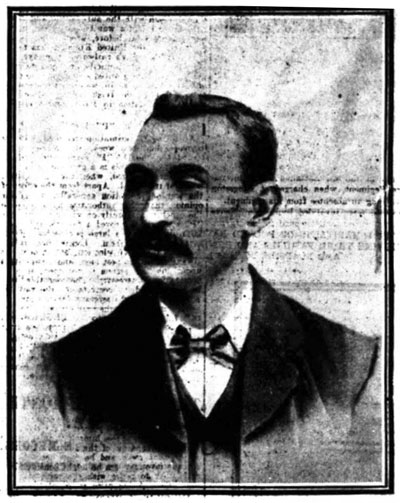 Captain Alexander McCorquodale.
Captain Alexander McCorquodale.
Mr C. A. Moore, general manager of the County Down Railway, Mr W. F. Minnis, traffic superintendent, the officers who served under him on the Erin’s Isle and a few personal friends. The coffin was then placed on the Glasgow steamer. The funeral took place on Saturday 5th September at Crarae, Argyllshire [13]. Captain Alexander McCorquodale was only 49 years of age and the cause of death was a pontine haemorrhage which is a form of intracranial haemorrhage, usually caused by long standing poorly controlled chronic hypertension. In December in the Probate Court, Dublin, Mr Andrews applied on the behalf of Robert McCorquodale, the deceased’s brother, for a grant of probate of a paper writing as being the last will of the deceased. The deceased, Alexander McCorquodale, had remained continuously all year round in the employment of the Belfast and County Down Railway Company. He had lived on the boat during the sailing season and lodged with Mrs Hanley, 35 Pilot Street, Belfast during the winter months when his vessel was lying up in Belfast docks. He visited the boat almost daily as he attended there to superintend repairs etc. On 8th October 1907 the deceased had executed a paper writing which purported to be a will without it being witnessed. The assets consisted of about £800 in stocks and shares. Mr Justice Madden decided that although the deceased was a seaman he was not at sea when the will was made and therefore refused the application [14].
In November 1915 the Erin’s Isle was taken over by the Admiralty to be used initially for transport purposes and later as a mine sweeper. On Friday morning, 7th February 1919, the Erin’s Isle was struck by a mine at 6am near the entrance to the Thames Estuary. The paddle steamer sank immediately. Twenty three lives were lost and twenty eight were rescued. The North Down Herald and County Down Independent of 15th February 1919 recorded that there would be many thousands who would regret her loss as that of an intimate friend, especially as she had safely emerged from the many dangers she had encountered during her useful Admiralty service only to meet her fate in 5 days of peace from a stray mine. The newspaper continued that it was probable that the County Down Railway Company would shortly announce arrangements for another steamer to resume the interrupted Bangor service but unfortunately that never happened. The railway company never ran paddle steamers again on the Belfast-Bangor route. The railway line from Holywood to Bangor had been doubled between 1897 and 1902 and the holiday traffic between Belfast and Bangor could be accommodated by running additional trains.
Bangor Boat Sails Again
In 1921 motor boats, Bangor King and Cingalee, ran daily between Belfast and Bangor leaving Ormeau Ferry, Balfour Avenue at 12 noon and 3pm and returning from Bangor at 7pm. Passengers were able to book up to the hour of sailing.
In 1923 Messrs Wilson & Reid, the shipowners, of Ulster Buildings, Waring Street, purchased a paddle steamer, Greyhound, to provide a service again during the summer between Belfast and Bangor. The Greyhound, which had been built in 1895 by Messrs J. G. Thomson, Clydebank, had been a well-known boat for the summer traffic between Blackpool and the Isle of Man. The boat would undergo a complete overhaul before taking her place in the Belfast Lough service. It was expected that the Greyhound would commence sailing early in June [15]. The paddle steamer, Greyhound, acquired by the Abercorn Steamship Company Ltd., had her trial trip to Bangor on the afternoon of 19th May. A large crowd lined up in the locality of the Queen’s Jetty to cheer the vessel as she left her moorings. There were over 200 guests on board, representing the civic and commercial interests of the city. The catering was carried out by Messrs E. and W. Pim, under the supervision of Mrs Newton of Pims’ Tea Rooms, Bangor. When the steamer arrived at Bangor she was saluted enthusiastically by young and old who had gathered to welcome her. On the return journey Councillor S. Donald Cheyne, J.P., submitted the toast:
Prosperity and long life to the Greyhound!!
He said that they all had pleasant memories of the Bangor service and they confidently looked forward to the Abercorn Steamship Company to maintain the old high standards. Men like Sir Thomas Wilson and Councillor Samuel Gray deserved the greatest credit for their enterprise. Mr C. A. Moore, general manager of the County Down Railway, said that so far as his company was concerned they did not regard the Greyhound in the light of opposition, but had entered into an arrangement whereby an interchange of tickets could be made, so that passengers by the steamer might return by rail if they wished, and vice versa [16].
On 29th May 1923 an advert was placed in the Belfast Telegraph announcing that the Greyhound would sail regularly on weekdays and Sundays from Queen’s Bridge Jetty, Belfast at 12 noon, 3 and 6.15pm, leaving Bangor at 1.15, 4.15 and 8pm. Lough cruises would commence on Saturday 2nd June and every subsequent Wednesday and Saturday throughout the Season as follows: Belfast to Bangor, Bangor to Larne Harbour, Larne Harbour to Bangor and Bangor to Belfast. The Greyhound would leave Belfast Jetty at 3pm, returning at 9pm. The following year the Greyhound was again maintaining regular sailings between Belfast and Bangor. The summer programme was also to include special one day lough cruises and occasional day trips to the Isle of Man.
The vessel also took emigrants to the Canadian liners anchored off Black Head. The Greyhound was engaged in doing this when a boiler pipe burst on board the Greyhound on Sunday morning, 13th July 1924. The explosion resulted in the deaths of two of the employees, fireman, Saunderson Bamford, aged 53, of Church Street East, Belfast and stoker, William Joss, aged 37, of Moffat Street, Belfast. Bamford died immediately of terrible scalds and Joss lingered until the following day until he too died of shock following extensive burns. An inquest was held the following month. As the vessel had been passed by the Board of Trade the verdict reached was accidental death. Later the Board of Trade issued a preliminary report with reference to the explosion from the boiler on board the paddle steamer Greyhound. The Engineer Surveyor in Chief stated that the water gauge fittings of this boiler were in duplicate, and if closer attention had been given to the readings of both gauges the defective working of the obstructive gauge would have been noticed and the explosion, which was clearly due to shortness of water in the boiler, would have been avoided [17]. On 25th April 1925 the Greyhound was sold to L’Administration de Navigazone a Vapeur Turque, Constantinople, for service between that city and the Princes Islands, in the sea of Marmara [18].
The North Down Herald and County Down Independent remarked in their paper of the same date:
The Greyhound paddle-steamer, who closed her career as a pleasure steamer between Bangor and Belfast by causing the death of some of her crew, has gone. I see to Constantinople. She didn’t go soon enough.
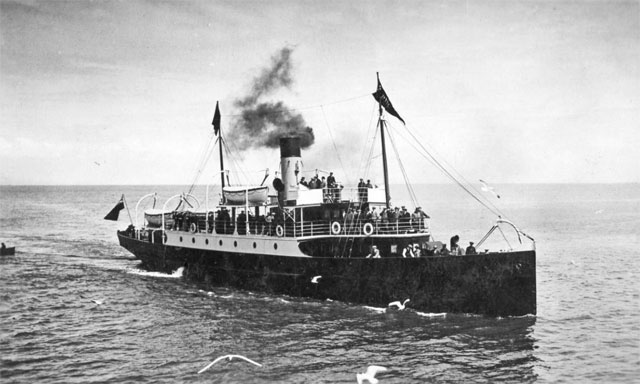 The Robina, www.clydeships.co.uk
The Robina, www.clydeships.co.uk
In early 1925 the Robina was purchased by the Ulster Steam Tender Company for tender work in connection with the large Atlantic liners which called regularly in Belfast Lough. The company also ran three hour cruises on Belfast Lough over Easter Week and during the summer season. The Robina was a steel screw steamer built in 1914 by Ardrossan Dry Dock & Shipbuilding Co. Ltd. [19]. She had been commandeered by the Admiralty in September 1914 and served as commodore’s ship to the fleet off the Isle of Wight during the First World War [20]. The Robina had a spacious saloon aft and a ladies’ cabin amidships and was capable of accommodating around 600 passengers. She left Queen’s Quay Jetty, Belfast at 11am and 3pm and after proceeding down the Victoria Channel sailed along the Antrim coast, giving a splendid view of Carrickfergus, Whitehead and Blackhead.
She then sailed to the Copelands and returned by way of Bangor Bay and the beautiful County Down coast. In 1927 the Robina began landing at Bangor where she could be boarded for a two hour lough cruise. An advert placed, in the North Down Herald and County Down Independent of 27th August 1927, began, ‘Your Vacant Sunday Afternoon! Use the Idle Hour for a Cruise in Bangor Bay’. The call at Bangor was discontinued in 1929 as the popular demand was for lough cruising only [21].
Owing to the big increase in the number of liners calling at Belfast another tender, the Smeaton, was purchased from the G. W. Railway Company in 1929 [22]. The Smeaton and Robina were both used for the Belfast Lough cruises. When warships were docked in Bangor Bay the Ulster Steam Tender Company ran cruises round the fleet and passengers, where permissible, were put on board a warship for one hour’s tour. In 1939 the Robina went to war again as the examination vessel in the Lough and later she brought ashore 50,000 of the troops who arrived in the Clyde on board the Queen Mary and the Queen Elizabeth. The Robina returned to Belfast in October 1945 but was sold in early 1946 to the Coast Lines Ltd. for service in the South of England [23].
In 1931 a syndicate of Belfast gentlemen purchased the paddle steamer Cynthia from Glasgow owners with the intention of reviving the passenger service between Belfast and Bangor. The company owning the vessel was known as the Cynthia Steamship Company and the managing agents were Messrs Stewart & Hewitt, Victoria Street, Belfast. The vessel had arrived in Belfast mid June and was starting sailings from Belfast to take passengers to the warships at Bangor. The vessel was fitted with a Marconiphone radio-gramophone installation and during evening cruises it was intended to have dancing and music. The following week regular sailings to Bangor would commence [24]. However, the company was dissolved towards the end of the following year [25].
After the Second World War had ended, in December 1948, Mr John Hall, a Dundee shipowner, hotel proprietor and amusement caterer, completed his plans to run a 14 knot motor launch, capable of carrying 230 passengers, between Belfast and Bangor. The Tourist Board promised support for his enterprise and already bookings of Lough Cruises were filling up [26]. The first trip was on 2nd May 1949 with proceeds going to the Ulster War Memorial Fund and the N.S.P.C.C.. The crews of the big steamers lining the Belfast Lough cheered the little cream and red Bangor Boat, named the Ulster Lady, as she sped down the lough. It had been 10 years since a boat had plied a holiday trade between Belfast and Bangor. It was planned to make four trips most days during the peak of the holiday season. Captain T. McGarry was the master in charge [27]. Chief officer of the Ulster Lady, James O’Kane, was married to Rose Connolly on the morning of 15th June 1949 in St Malachy’s Church, Belfast. Afterwards the Chief Officer and his new bride stood in the bows of the Ulster Lady as she sailed out of the sunlit harbour. The guests, numbering over fifty, joined the newly-wedded couple on a lough cruise during which the wedding breakfast was served [28]. The following year the portable wooden hut, formerly used by John Hall Cruises, was put up for sale in the Belfast Newsletter on 27th November.
An attempt was made in 2001 by Loughlink Ltd. to run a commuter service joining Bangor, Carrickfergus and Central Belfast. The company was incorporated on 2nd February 2001. Julian Simmons announced in the Sunday Life of 26th August 2001 that there would soon be a hassle-free, fast and reliable alternative to battling through traffic jams in cars and buses, and stopping at every hole in the hedge on trains. The firm took delivery of two new £1.5m catamarans, capable of conveying 114 Bangor or Carrickfergus commuters at a time in just under half an hour, to and from pontoons at Donegall Quay and the Odyssey Centre but the two directors of the company resigned on 15th November 2001 and the company folded [29].
References
- Northern Whig, 11th August 1894.
- The Irish News and Belfast Morning News, 30th May 1894
- www.clydeships.co.uk
- Belfast Newsletter, 27th December 1894.
- Northern Whig, 24th September 1894.
- Newtownards Chronicle, 23rd May 1896.
- Northern Whig, 12th December 1911.
- Belfast Telegraph, 17th May 1912.
- Belfast Telegraph, 7th June 1912.
- Belfast Newsletter, 13th June 1912.
- Belfast Newsletter, 12th July 1912.
- Belfast Weekly Telegraph, 4th September 1915.
- Belfast Newsletter, 6th September 1915.
- Larne Times, 18th December 1915.
- Northern Whig, 13th April 1923.
- Belfast Telegraph, 19th May 1923.
- Belfast Telegraph, 8th January 1925.
- Ballymena Weekly Telegraph, 25th April 1925.
- www.clydeships.co.uk
- Northern Whig, 28th May 1925.
- Belfast Newsletter, 5th June 1929.
- Ballymena Weekly Telegraph, 28th February 1931.
- Belfast Telegraph, 28th January 1946.
- Northern Whig, 18th June 1931.
- The Belfast Gazette, 16th December 1932.
- Belfast Telegraph, 2nd December 1948.
- Northern Whig, 3rd May 1949.
- Belfast Telegraph, 15th June 1949.
- www.companycheck.co.uk
